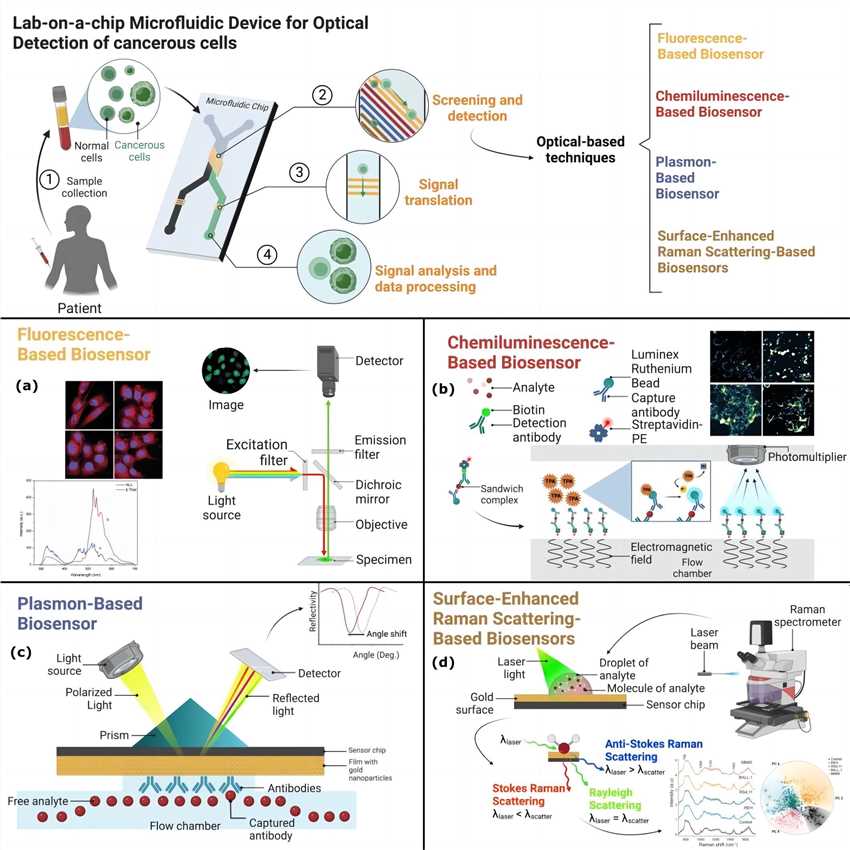Suitable detection techniques are required to be coupled to Microfluidics in order to analyze experiment outcomes in a sensitive and scalable way. Microfluidic optical devices are the emerging technology that combines today’s Microfluidics technology with the optics. Several classifications of optical detection techniques can be done based on the optical method, the imaging systems or the presence or not of lenses. In brief, detection systems can be divided into off-chip and integrated devices.
Conventional and Off-Chip Imaging Methods
Microfluidics has been widely coupled to bright-field, phase-contrast, confocal and differential interference contrast (DIC) microscopy as well as interferometers. For off-chip system, the detection components including light source, mirror and detector are not integrated within the Microfluidic device and light propagates in air. Optical detection is the dominant detection technique due to instrumentations availability and the ease to couple the systems to Microfluidic platforms. Nowadays, optical detection provides for use of light-emitting diodes (LEDs), lasers, diodes as light sources, microlenses, waveguides and optical fibers for detection and photomultiplier tubes (PMTs), charge-coupled devices (CCD), and complementary metal-oxide-semiconductor (CMOS) as sensors.
- Fluorescence Microfluidics
- Colorimetric Microfluidics
- Chemiluminescence Microfluidics
- Lens-Less Shadow Imaging
 Fig.1 Optically-integrated lab-on-a-chip microfluidic systems.1
Fig.1 Optically-integrated lab-on-a-chip microfluidic systems.1
Integrated On-Chip Imaging Methods
In on-chip imaging systems, optical and optoelectronic components are fully integrated within the Microfluidic platform. The main advantages of these systems in comparison with off-chip devices are increased portability, sensitivity, operator-independence, integration and the ability to tune the optical properties. Besides, on-chip imaging can be performed through lens-free techniques such as shadow imaging or digital inline holography.
Optical Detection Components for Microfluidics
- Light Sources
Commercial LEDs and miniaturized diode lasers as light sources have been widely used in Microfluidics setup. Low-cost while organic LEDs and dye lasers are the most widely used optofluidic light sources in current literature because the ease to be fully integrated within Microfluidic systems and their versatility.
- Detectors
Optical detection can be performed by using a wide range of different detectors. The conventional ones are photomultiplier tubes (PMTs), charge-coupled device (CCD) sensors. Integrated detectors are usually photodiodes such as silicon or organic- organic photodiodes (OPDs) and complementary metal-oxide-semiconductor (CMOS) sensors. These biosensors also permit lens-free imaging.
- Optical Components to Increase Detection
Extra optical components are usually used to increase detection. For instance, a standard and diffused approach is to use optical fibers, that can both transmit and detect light, are easy to come by and suitable for combination with other optical components. Absorbance, fluorescence and interferometry measurements can be improved by introduction of microlenses and waveguides. Waveguides can be classified as evanescent wave-based, such as liquid-core waveguides (LCWs) or interference based, as in the case of photonic crystals antiresonant reflecting optical waveguides (ARROWs) detectors.
As the increasing demand for automated, robust, cheap and portable platforms for a wide range of diagnosis applications, scalable and sensitive optical detectors are required. Development of smartphone-based point-of-care diagnosis solutions enables to move towards fast, low-cost and simple analysis by using the smartphone camera as both light source and detector. Sustained efforts have been made by Creative Biolabs to develop platforms with imaging systems based on high-speed optical technology to go beyond the spatial and temporal limits of conventional optical detection methods. For more information, please directly contact us for more information.
Reference
- García-Hernández, Luis Abraham, et al. "Optical Detection of Cancer Cells Using Lab-on-a-Chip." Biosensors 13.4 (2023): 439. Distributed under Open Access license CC BY 4.0, without modification.
For Research Use Only.

